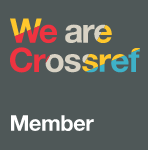Submissions
Submission Preparation Checklist
As part of the submission process, authors are required to check off their submission's compliance with all of the following items, and submissions may be returned to authors that do not adhere to these guidelines.- The submission is original, has not been previously published, currently under review or submitted to another journal for possible publication (otherwise, an explanation has been provided in Comments to the Editor).
- The submission file is prepared following the 'Author Guidelines'. The text adheres to the stylistic and bibliographic requirements as outlined in the 'Author Guidelines'. Where available, URLs for the references have been provided.
- The submission file is in Microsoft Word document file format. The text is single-spaced, 12-point font, employs italics, rather than underlining (except with URL addresses).
- All illustrations, figures, and tables are placed within the text at the appropriate places with proper caption and relevant description, rather than at the end.
Original Research
This is the most common type of journal manuscript used to publish full reports of data from research. It should be Original Research. Original Research can be from different fields and different types of studies. The article content should include full Introduction, Methods, Results, and Discussion sections and conclusion.
Review
Review Articles provide a comprehensive summary of research on a certain topic, and a perspective on the state of the field and where it is heading.
Case Studies
These articles report specific instances of interesting phenomena. A goal of Case Studies is to make other researchers aware of the possibility that a specific phenomenon might occur.
Copyright Notice
The publication of an article in peer-reviewed “EDU Journal of Computer and Electrical Engineering" is an essential building block in the development of a coherent and respected network of knowledge. It is a direct reflection of the quality of the work. Peer-reviewed articles support and embody the scientific method. It is therefore important to agree upon standards of expected ethical behavior for all parties involved in the act of publishing: the author, the journal editor, the peer reviewer, the publisher, and the society of society-owned or sponsored journals.
All authors are requested to disclose any actual or potential conflict of interest including any financial, personal or other relationships with other people or organizations within three years of beginning the submitted work that could inappropriately influence, or be perceived to influence, their work.
Submission of an article implies that the work described has not been published previously that it is not under consideration for publication elsewhere. The submission should be approved by all authors and tacitly or explicitly by the responsible authorities where the work was carried out, and that, if accepted, it will not be published elsewhere in the same form, in English or in any other language, including electronically without the written consent of the copyright holder.
Upon acceptance of an article, authors will be asked to complete a “Copyright Form”. Acceptance of the agreement will ensure the widest possible dissemination of information. An e-mail will be sent to the corresponding author confirming receipt of the manuscript together with a “Copyright Form” form or a link to the online version of this agreement.
Author Rights
As a journal author, you retain rights for a large number of author uses, including use by your employing institute or company. These rights are retained and permitted without the need to obtain specific permission from EJCEE. These include:
- the right to make copies (print or electronic) of the journal article for your own personal use, including for your own classroom teaching use;
- the right to make copies and distribute copies (including via e-mail) of the journal article to research colleagues, for personal use by such colleagues for scholarly purposes;
- the right to post a pre-print version of the journal article on Internet web sites including electronic pre-print servers, and to retain indefinitely such version on such servers or sites for scholarly purposes
- the right to post a revised personal version of the text of the final journal article on your personal or institutional web site or server for scholarly purposes
- the right to use the journal article or any part thereof in a printed compilation of your works, such as collected writings or lecture notes.
Privacy Statement
The names and email addresses entered in this journal site will be used exclusively for the stated purposes of this journal and will not be made available for any other purpose or to any other party.






